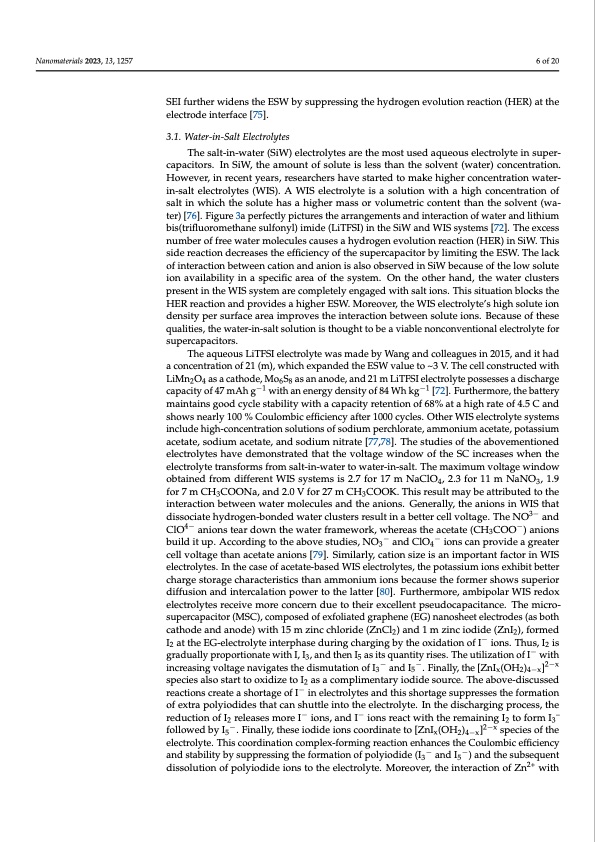PDF Publication Title:
Text from PDF Page: 006
Nanomaterials 2023, 13, 1257 6 of 20 SEI further widens the ESW by suppressing the hydrogen evolution reaction (HER) at the electrode interface [75]. 3.1. Water-in-Salt Electrolytes The salt-in-water (SiW) electrolytes are the most used aqueous electrolyte in super- capacitors. In SiW, the amount of solute is less than the solvent (water) concentration. However, in recent years, researchers have started to make higher concentration water- in-salt electrolytes (WIS). A WIS electrolyte is a solution with a high concentration of salt in which the solute has a higher mass or volumetric content than the solvent (wa- ter) [76]. Figure 3a perfectly pictures the arrangements and interaction of water and lithium bis(trifluoromethane sulfonyl) imide (LiTFSI) in the SiW and WIS systems [72]. The excess number of free water molecules causes a hydrogen evolution reaction (HER) in SiW. This side reaction decreases the efficiency of the supercapacitor by limiting the ESW. The lack of interaction between cation and anion is also observed in SiW because of the low solute ion availability in a specific area of the system. On the other hand, the water clusters present in the WIS system are completely engaged with salt ions. This situation blocks the HER reaction and provides a higher ESW. Moreover, the WIS electrolyte’s high solute ion density per surface area improves the interaction between solute ions. Because of these qualities, the water-in-salt solution is thought to be a viable nonconventional electrolyte for supercapacitors. The aqueous LiTFSI electrolyte was made by Wang and colleagues in 2015, and it had a concentration of 21 (m), which expanded the ESW value to ~3 V. The cell constructed with LiMn2O4 as a cathode, Mo6S8 as an anode, and 21 m LiTFSI electrolyte possesses a discharge capacity of 47 mAh g−1 with an energy density of 84 Wh kg−1 [72]. Furthermore, the battery maintains good cycle stability with a capacity retention of 68% at a high rate of 4.5 C and shows nearly 100 % Coulombic efficiency after 1000 cycles. Other WIS electrolyte systems include high-concentration solutions of sodium perchlorate, ammonium acetate, potassium acetate, sodium acetate, and sodium nitrate [77,78]. The studies of the abovementioned electrolytes have demonstrated that the voltage window of the SC increases when the electrolyte transforms from salt-in-water to water-in-salt. The maximum voltage window obtained from different WIS systems is 2.7 for 17 m NaClO4, 2.3 for 11 m NaNO3, 1.9 for 7 m CH3COONa, and 2.0 V for 27 m CH3COOK. This result may be attributed to the interaction between water molecules and the anions. Generally, the anions in WIS that dissociate hydrogen-bonded water clusters result in a better cell voltage. The NO3− and ClO4− anions tear down the water framework, whereas the acetate (CH3COO−) anions build it up. According to the above studies, NO3− and ClO4− ions can provide a greater cell voltage than acetate anions [79]. Similarly, cation size is an important factor in WIS electrolytes. In the case of acetate-based WIS electrolytes, the potassium ions exhibit better charge storage characteristics than ammonium ions because the former shows superior diffusion and intercalation power to the latter [80]. Furthermore, ambipolar WIS redox electrolytes receive more concern due to their excellent pseudocapacitance. The micro- supercapacitor (MSC), composed of exfoliated graphene (EG) nanosheet electrodes (as both cathode and anode) with 15 m zinc chloride (ZnCl2) and 1 m zinc iodide (ZnI2), formed I2 at the EG-electrolyte interphase during charging by the oxidation of I− ions. Thus, I2 is gradually proportionate with I, I3, and then I5 as its quantity rises. The utilization of I− with increasing voltage navigates the dismutation of I3− and I5−. Finally, the [ZnIx(OH2)4−x]2−x species also start to oxidize to I2 as a complimentary iodide source. The above-discussed reactions create a shortage of I− in electrolytes and this shortage suppresses the formation of extra polyiodides that can shuttle into the electrolyte. In the discharging process, the reduction of I2 releases more I− ions, and I− ions react with the remaining I2 to form I3– followed by I5−. Finally, these iodide ions coordinate to [ZnIx(OH2)4−x]2−x species of the electrolyte. This coordination complex-forming reaction enhances the Coulombic efficiency and stability by suppressing the formation of polyiodide (I3− and I5−) and the subsequent dissolution of polyiodide ions to the electrolyte. Moreover, the interaction of Zn2+ withPDF Image | Water-in-Salt Eutectic Solvent-Based Liquid Electrolytes

PDF Search Title:
Water-in-Salt Eutectic Solvent-Based Liquid ElectrolytesOriginal File Name Searched:
nanomaterials-13-01257.pdfDIY PDF Search: Google It | Yahoo | Bing
Salgenx Redox Flow Battery Technology: Power up your energy storage game with Salgenx Salt Water Battery. With its advanced technology, the flow battery provides reliable, scalable, and sustainable energy storage for utility-scale projects. Upgrade to a Salgenx flow battery today and take control of your energy future.
CONTACT TEL: 608-238-6001 Email: greg@infinityturbine.com (Standard Web Page)